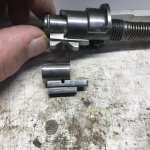Something about this rifle attracted me when I saw it on a recent auction. I think it was the smooth blued finish and the swing safety. I figure that the safety was a pricy addition so the previous owner must cared about the build. When I received it, I confirmed my suspicions as the metal appears to be refinished and a nice Bord aftermarket trigger made it a pleasure. Pretty impressive for an action that’s over 100 years old. The barrel is 308 so a perfect match for the intermediate length Mauser action.
What’s strange to me is the stock and barrel. I don’t know too much about stock materials. This stock looks hand made with clear imperfections/errors. The material is extremely light - the surface feels like a very stiff/hard foam. I’ve attached some closeup photos. The barrel is also a strange profile as well, somewhere between a standard sporter and medium. Tapers from 0.9” to 0.6” very heavy for a Hunter and there’s no sling swivels.
Would like to be schooled a bit about these old customs. Do you think this was intended to be a varmint setup? What is the chance I will find another stock for this rare action?




What’s strange to me is the stock and barrel. I don’t know too much about stock materials. This stock looks hand made with clear imperfections/errors. The material is extremely light - the surface feels like a very stiff/hard foam. I’ve attached some closeup photos. The barrel is also a strange profile as well, somewhere between a standard sporter and medium. Tapers from 0.9” to 0.6” very heavy for a Hunter and there’s no sling swivels.
Would like to be schooled a bit about these old customs. Do you think this was intended to be a varmint setup? What is the chance I will find another stock for this rare action?






















































































